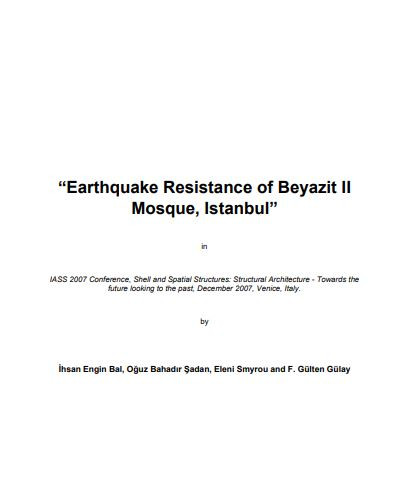
Beyazit Mosque is a classical type Ottoman structure built between 1501 and 1506. Its original structural system is a combination of Hagia Sophia consisting of four main arches and semi-domes, and Ottoman construction techniques. The mosque contains four great brick and cut-stone composed arches springing from stone piers that offer primary support for a central dome of 16.78m diameter and 36.5m height and two semi-domes. The mosque experienced a strong earthquake just 3 years after its opening and was repaired immediately. After some strong earthquakes in the following years, Sinan, known as the master of the Ottoman architecture, retrofitted the mosque by adding some external jacketing to the columns, with anchorages and a modified cut-stone arch system. The importance of the mosque also lies on the fact that it is the first mosque which was constructed with the same structural type (two semi-domes) as Hagia Sophia after the conquest of the city in 1453. In this paper, the intervention applied by Sinan has been investigated in detail. Additionally, in order to complete the 3D elastic model of the monument, the effect of the additional arches and the column jacketing have been examined by employing nonlinear analysis techniques. The conditions of the 1509 earthquake have been simulated by using a reasonably similar scenario earthquake triggered by the Marmara segments of the North Anatolian Fault. The reasons caused the partial collapse of the dome in 1509 and the effects of the retrofitting by Sinan to improve the stability of the central dome and semi-domes have been examined.
Bal, İhsan Engin, Oğuz Bahadır Şadan, Eleni Smyrou, and F. Gülten Gülay. “Earthquake Resistance of Beyazit II Mosque, Istanbul.” In IASS 2007 Conference, Shell and Spatial Structures: Structural Architecture-Towards the future looking to the past, Venice, Italy. 2007.
I agree to the terms outlined below:
You agree to upload and assign Mosqpedia Database the rights to use the content worldwide and in perpetuity across all current and future media platforms. Mosqpedia Database may edit, copy, adapt and translate your contribution.
The content will be distributed under the Creative Commons Attribution-Deed – Attribution-NonCommercial-NoDerivatives 4.0 International – Creative Commons
All data will be stored in line with data protection regulations.